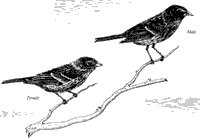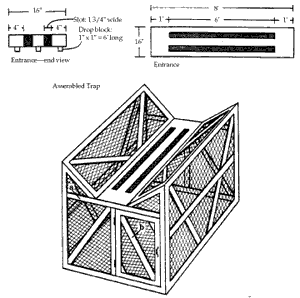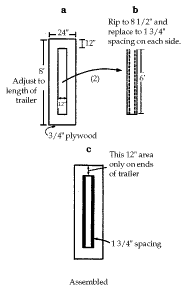|
House Finches | House Finch Damage Assessment | House Finch Damage Management | House Finch Resources | House Finch Acknowledgments | House Finch Damage Control Summary | ICWDM | Wildlife Species Information |
Contents |
Damage Prevention and Control Methods

Exclusion
Install protective plastic netting (1/2-inch [1.25-cm] mesh) to protect crops such as blueberries, bush berries, and strawberries. Although costly, this approach has been very effective at reducing damage.
Habitat Modification
Remove large brush piles, stacks of irrigation pipe, and piles of boxes to eliminate nesting and resting areas for house finches.
Frightening
Frightening devices in general have little practical value in protecting crops from house finches. Good results have been reported in the use of Av-Alarm® and gas cannons mounted above the crop and moved frequently. Flags, dangling papers, aluminum foil, and scarecrows have little value as methods of crop protection.
Avitrol® Mixed Grain (0.5%) is a toxic chemical that produces flock-alarming reactions in birds that ingest a sufficient quantity. It is currently registered in California to control house finches in grape vineyards. Six-to 8-foot (1.8- to 2.4-m) V-shaped troughs should be placed 1 to 3 feet (30 to 90 cm) above the vines. Begin prebaiting with untreated bait (one part Dwarf Essex rape seed and three parts canary grass seed) when 50 or more house finches are feeding in the vineyard. Prebait each morning for several days until maximum feeding activity is achieved.
Clean troughs of prebait before exposing Avitrol-treated bait. A ratio of two parts untreated seed to one part treated seed is recommended. The treated bait should be exposed in the troughs for 1 to 4 days. Thereafter, the treated bait should be replaced with clean seed until feeding activity approaches maximum bait acceptance. The prebaiting and baiting with treated grain cycle should be repeated as often as necessary until harvest.
In vineyards, use one trough per acre (2.5/ha). Smaller vineyards usually require more troughs per acre than do larger fields. Bait should be replaced if it becomes water-soaked, or if depleted by birds, insects, or rodents.
Repellents
Methyl anthranilate (Fruit Shield®) is currently registered for ornamentals, corn, sunflower, a variety of fruit crops, and structures.
Toxicants
None are registered.
Trapping
Australian crow traps are used to capture crows, magpies, and ravens. The traps, however, can be modified by changing the entrance, and used to capture house finches, crowned spar-rows, house sparrows, starlings, and blackbirds (Fig. 2). Minor modifications can be made to fit the trap on a truck or trailer. The basic design of the trap, however, should not be changed. Cotton trailers can be converted into traps (Fig. 3) and have been effective in trapping large numbers of house finches. Use small wire mesh, such as 1/2 x 1/2-inch (1.2 x 1.2-cm) mesh hardware cloth or aviary wire to cover traps used for house finches.
Proper trap location is one of the most important factors in achieving good results. Observe the problem area to determine flyways and resting, perching, and feeding areas before placing traps. Place traps in open areas where they can be easily seen. Traps have been most effective where birds enter fields and orchards or near resting and perching sites.
Trapped house finches serve as decoys to other birds. Decoy birds are usually essential in attracting other house finches. Use 1 to 15 live decoys, depending on the size of the trap. Provide food and water in flat containers at all times to keep decoy birds alive and to make the trap more attractive to capture birds.
Back to Top

Important Assembly Instructions
Place end panels between side panels; otherwise, top panels will not fit properly. Note:
- a. Reinforce this area with a 2 x 4 x 16-inch (5 x 10.2 x 40.6-cm) piece of wood. This provides
a greater surface area for the entrance to rest on.
- b. Place a small door in this area for removal of trapped birds.
Materials Needed For Trap:
- 15 boards – 1 x 4’s, 8 feet long (2.5 x 10.2 cm, 2.4 m long)
- 25 boards – 1 x 4’s, 6 feet long (2.5 x 10.2 cm, 1.8 m long)
- 4 boards – 1 x 1’s, 8 feet long (2.5 x 2.5 cm, 2.4 m long) 1/2-inch exterior plywood – 16 inches x 8 feet (40.1 cm x 2.4 m) 1/2-inch mesh aviary wire -3 x 80 feet (0.9 x 24.4 m)
- 2 hinges
- staples
Figure 3. Converted cotton trailer trap.


a Adjust to length of trailer b Rip to 8 1/2″ and replace to 1 3/4″ spacing on each side. c This 12″ area of trailer only on ends of trailer 1 3/4″ spacing
Materials:
- 1/2-inch exterior plywood – 16 inches x 8 feet (40.1 cm x 2.4 m)
- 2 boards – 2 x 6’s, 7 feet long (5 x 15.2 cm) (supports)
- 2 boards – 2 x 6 x 8 3/4 inches (5 x 15.2 x 22.2 cm) (braces)
- 1/2-inch mesh aviary wire -3 x 80 feet (0.9 x 24.4 m)
- Instructions
Install the 2 x 6 (5 x 15 cm) supports to prevent warping of plywood. Mount them on outside edge of plywood at (a). Mount the braces at (b). These are needed to support the entrance insert panels. Remove a 12-inch x 6-foot (30.5-cm x 1.8-m) section from the middle of the plywood. Cut 3 1/2 inches (8.9 cm) from one side of the removed section of plywood, making the panel 8 1/2 inches by 6 feet long (21.6 cm x 1.8 m). Insert this panel into the original 12 inch x 6 foot (30.5-cm x 1.8-m) cut. This provides a trap entrance with two, 1 3/4-inch (4.4-cm) slots.
Canary grass seed, wild bird seed mix, or chick scratch (cracked corn, milo, and other grains) work well to maintain decoy birds. Install 1/4-inch (0.6-cm) dowel rods to serve as perches, especially in larger traps. Perches should run the full length of the trap, and be located about 1 foot (30 cm) from the sides and halfway between the top and the bottom of the trap. Cold winds or hot sun can stress trapped birds. Fasten burlap to the sunny side of the trap to provide shade in the summer.
Birds can be removed from modified Australian crow traps by catching them with your hand or a small net. Several birds can be removed by cutting a 6 x 6-inch (15 x 15-cm) exit hole that is easily opened and closed in an upper corner of the rear of the trap. Place a small holding cage on the outside of the trap over the open exit hole and herd the birds from the trap into the holding cage. To euthanize the birds, place the holding cage in a plastic bag and inject carbon dioxide through a hose until the birds are dead. Burn or bury the dead birds.
Shooting
Shooting will somewhat reduce the number of birds present but is a costly and rather futile method of crop protection.
Back to Top
|
House Finches | House Finch Damage Assessment | House Finch Damage Management | House Finch Resources | House Finch Acknowledgments | House Finch Damage Control Summary | ICWDM | Wildlife Species Information |
Summary of Damage Prevention and Control Methods
Exclusion
Cover crops with plastic netting.
Habitat Modification
Remove cover used for nesting and resting.
Frightening
Av-Alarms® and gas cannons have been somewhat effective.
Avitrol®
Repellents
Methyl anthranilate.
Toxicants
None are registered or currently avail-able for use.
Trapping
Modified Australian crow traps, converted cotton trailer trap.
Shooting
Limited effectiveness
